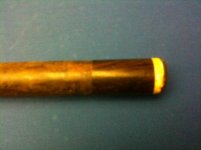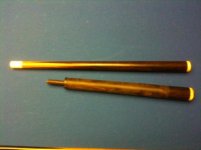A guy I play billiards with asked me to help him get some info on this cue he had handed down to him, he thinks it is from the 1800's. Very thin cue, joint seems to be about 1/2 the diameter of a newer cue. the shaft is ebony and maple with a splice about half way. the butt has a big pin joint right above the handle, like a jump/break cue. the shaft has a thin metal pin. there is an ivory joint and an ivory rambow ring at bottom, and a linen or nylon wrap. no markings anywhere
You are using an out of date browser. It may not display this or other websites correctly.
You should upgrade or use an alternative browser.
You should upgrade or use an alternative browser.
Rambow ??
- Thread starter seanandnik
- Start date
I would say not a Rambow. Not sure what it is. But there are far more knowledgable people on here than me with these old cues.
Looks to me to be a Brunswick "Hub cue". It's highly possible that it was made in the "Rambow era"....I say that because he worked there up through the 50s, except a few years in the 20s, iirc. If I had to guess from the looks of this one.....probably ~20-30s era. Hope this helps. Wrap is probably silk.
Hub
Yea, it looks like a hub cue, it is in pretty good condition. What years were they made and what's a rough value ?
Yea, it looks like a hub cue, it is in pretty good condition. What years were they made and what's a rough value ?
"By the early 1920s, Herman Rambow was involved in cuemaking at Brunswick. He invented the "Hub Cue," which featured an ivory joint above the wrap, and a bell-shaped ivory ferrule. Rambow also used the bell ferrule on some of his own cues into the 1940s. Brunswick was the first to make the "Hub" in the 1920s, and today they are sought after by collectors as a very important historical cue. Most of these early cues were sold with a "Brunswick Balke Collender" decal on the butt sleeve, which are particularly prized when they remain intact on the cues. (See examples shown.) Some restored cues have replicas of the early decals, which changed in color and small details over the decades."
Herman Rambow left Brunswick and started the Superior Cue Mfg. and Billiard Supply Company in 1921, because he felt that Brunswick was not giving him credit for his idea's. Now between the years of 1921 and 1926 Herman worked on his own, since he left Brunswick and since Brunswick challenged his design of the Hub Cue, Herman had little choice but to sell cues and merchandise either to private individuals or to Brunswick's competition.
In 1925 the dispute between Brunswick and Rambow ended when Herman was awarded a Patent from the US Patent Office (Patent Number 1,527,748), shortly after this also in 1925, Herman signed his Patent Rights over to Brunswick for unknown reason's. Then in 1927 Herman was back working for Brunswick as the Head Foreman for all cue operations, until his retirement in 1950.
During the the Six Year's that Herman worked on his own from 1921 until 1927 documentation of his activities are very scarce, however, cues that were his trade mark appear, made in the same fashion and using the same construction techniques that Herman was known for. One cue style in particular shows up with the name imprints / manufacturing marks of J.E. Came of Boston, and O.L. Briggs Company and that is the Rambow Hub cue. It is certainly possible that these companies purchased these cues from Herman unmarked and that they added their name stamps to them, or it is also possible that they made these cues themselves, however, when you consider that Patent thief was as much a crime then as it is now I would suspect that Herman was involved in some manner. In addition all the Hub Cues I have seen with the Name stamps of other companies appear to have been made during the 1920's, this is due to the location of the weight stamp, and the materials used for joining and building these cues.
Hopefully more information will come to light in the future, and this is the only way to close the book on this conversation.
JIMO


